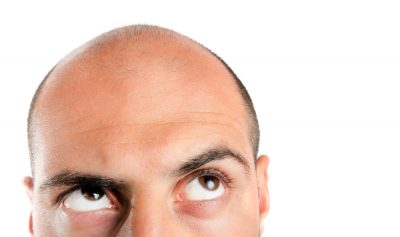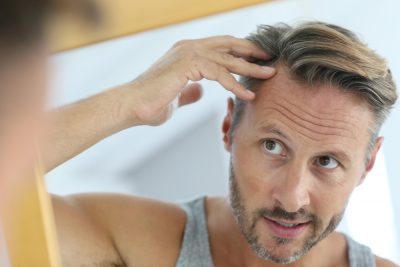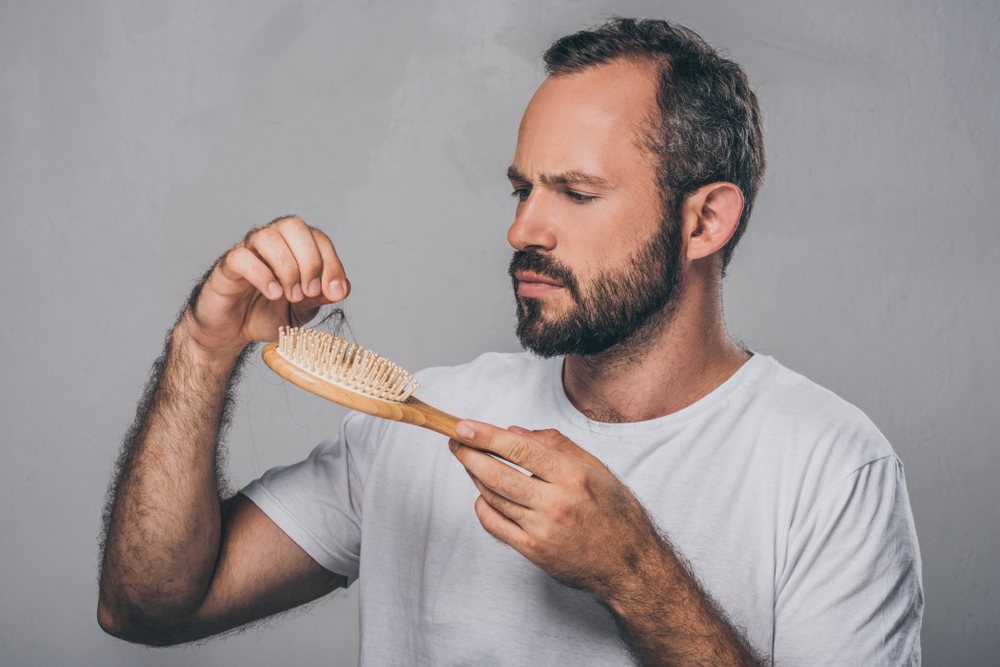What’s the first thing that enters your mind when you think of men like Michael Jordan, Wayne Rooney, and LeBron James?
Well, you’ve got world-class athletes known the world over, who are the definition of masculinity, and popular with fans, both male and female, all over the world.
Oh, and before we forget anything else, they’re bald.
Much has been said about bald men being more masculine. That’s because they are thought to have higher testosterone levels, making them more virile and libidinous. But there’s a tradeoff: they go bald at a younger age than average. This leads to more interesting, yet more compound results.
This much we know: testosterone plays an integral role in male pattern hair loss, or balding. This was first discovered in a Yale study conducted in 1960 by a doctor by the name of James Hamilton. In short, he discovered a link between testosterone and baldness based on boys who underwent castration.
The castrated boys were studied for many years – and they were found to have intact hair, as opposed to their “unfixed” peers who had their testicles intact and producing testosterone, or who were balding or experienced some form of male pattern hair loss.
This finding prompted suggestions that above-average levels of testosterone may be a precursor to balding.
However, it is known that the levels are of no consequence, provided that there is a presence of testosterone in the body. For instance, castrated men might retain their hair, but men who are diagnosed with low T can nevertheless still lose their hair.
How do genetics and testosterone interact?
That said, it’s not the amount of testosterone in your body that determines whether you will go bald – rather, it all boils down to genetic characteristics. Baldness is a result of genetics, making hair follicles react sensitively to testosterone circulating in your bloodstream.
While this interaction hasn’t been fully explored yet, what we DO know is that an enzyme converts testosterone to a biochemical substance called dihydrotestosterone (DHT).
 DHT causes hair follicles to shrink, which curtails blood supply to them, leading to a significant decrease in the hair growing process, and in effect, leading to finer and finer hair until only the finest hairs are left growing.
DHT causes hair follicles to shrink, which curtails blood supply to them, leading to a significant decrease in the hair growing process, and in effect, leading to finer and finer hair until only the finest hairs are left growing.
In time, the hair follicle eventually stops producing hair – and typically starts on top of the scalp moving downwards to create the typical male pattern hair loss shape.
Bald men are thusly genetically inclined to be more reactive to DHT. However, the hair follicles on the face are typically untouched by the hormone, which allows bald men to continue growing facial hair.
How does DHT work?
Testosterone is converted into DHT by the enzyme called 5-alpha-reductase (5-AR) in the testicles, as well as the prostate, skin, and other body parts.
About 10% of testosterone is processed into DHT daily – while it is thought that the percentage is lower before males hit puberty, which would demonstrate why there are no babies rocking beards at their young ages.
As DHT circulates your body, it attaches itself to receptors scattered across the body, including the receptors located in the follicles of the hair.
DHT is more potent than testosterone and is thought to be the more appropriate reason why men act masculine. In essence, testosterone is receiving the credit that should otherwise be going to DHT. DHT and testosterone go together, and it would not be out of the question to think that boosting your testosterone may influence the amount of DHT that your body produces. As you will now understand, nothing is as ever as simple with how the body works.
DHT and balding
DHT is undoubtedly one of the main reasons as to why men go bald. It would be good to first discuss how hair grows to understand why. The process of creating the thing on your head called your hair goes through three phases as follows.
The first phase (anagen)
This phase of the hair growth cycle represents the stage when it starts growing. Cells found in the roots of the follicles of the hair rapidly recreate themselves during this phase, leading to hair growing at a half-inch pace every month.
The second phase (catagen)
This is when hair growth stops and the strands detach from their follicles, and then attach to skin. This is the part where the hair gets cut off from the blood supply.
The third phase (telogen)
This is the stage where the new hair forces the old out and leads it to falling off during this phase, lasting for a couple to 4 months. When the hair is shed, the follicle returns to the first phase and starts over again with the growth cycle.
It typically takes about two to around 6 years to go around the complete cycle. Men who have a predilection to DHT will find themselves in the category that results in thinner hair that’s more susceptible to breakage, thus falling complete from the scalp at a faster pace.
While it is true that as with everything during the aging process, hair follicles tend to shrink, which leads to thinning hair, recent research shows that high DHT levels increase the rate at which the follicles begin to wither, which inevitably results in hair loss.
Once again, it all boils down to your genetics. This always varies depending on the subject’s genetics as well as the unique characteristics of their scalp, particularly when it comes to DHT sensitivity.
What treatment methods are available for male pattern hair loss?
As more knowledge about testosterone’s important influence in promoting masculine characteristics has emerged, the same can be said for the treatment options.
Men who retain their full head of hair have been found to possess lower levels of the enzyme that is responsible for converting testosterone to DHT. That’s why researchers have been hard at work trying to find a way to block this enzyme in other men who might be predisposed to baldness.
There are expensive treatments that work in this manner, but require constant use else balding returns – finasteride is one of these examples.
Nevertheless, scientists continue to research the exact process that triggers the stoppage of the growth process. However, male pattern hair loss seems to be fraught with urban legends and old wives’ tales as opposed to other health conditions. This is probably because of how men go bald seems to be so random that we find the need to come up with a somewhat logical explanation.
That said, if you have gone bald, or are in the process of doing so, the sad truth is that you can’t chalk it up to your virility – rather, baldness is passed on via genetics.
For sure, one of the hallmarks of aging – and one of its most irritating symptoms – has got to be male pattern hair loss. It’s not a mystery why it is so; if you’re starting to lose hair, it will have an impact on your look which could in turn impact your confidence.
The question remains, then: is thinning hair a symptom of low testosterone, or does low testosterone have anything at all to do with this sign of aging?
What causes hair loss in men?
Hair loss is more prevalent in men than women – which is why the school of thought that believes testosterone and hair loss are interlinked first emerged. But the correlation, as we’ve discussed in great detail earlier, isn’t as simple as we wish it was. Increasing your testosterone levels won’t stop you from going bald, or make your hair grow back as though nothing happened.
Let’s put together the three primary causes of male pattern hair loss or thinning hair in men.
Genetics
 This is the most likely reason for most balding or bald men. If male pattern hair loss is a prevalent in your family, there is little you can do to stop your hair loss – it is, after all, a question of genetics.
This is the most likely reason for most balding or bald men. If male pattern hair loss is a prevalent in your family, there is little you can do to stop your hair loss – it is, after all, a question of genetics.
Hormonal disparity and disequilibrium
Low testosterone might play a part in hair and balding issues, and they definitely can cause auxiliary health issues that are all too often dismissed as signs of aging – but, like balding, these health issues can take a toll on your self-esteem and mental health if not processed the right way.
Age
Mother Nature always bats last. And when she does, there’s nothing mere mortals like you and I can do about it. Like genetics, age is another factor that you simply cannot do anything about. The older you are, the more increasingly likely you are to experience thinning hair or balding. In the end, almost all men experience hair loss by age 70.
Conclusion
Granted, while we can say that hair loss and testosterone aren’t seemingly directly related, we can still draw some useful conclusions out of what we know. The reason why testosterone replacement therapies are becoming a popular solution for men. Thing is, many times, low testosterone primarily influences hair loss in the chest, arms, or legs, and not as much when it comes to the head.
Low T can also come with a host of other more disturbing side effects that would be more of a pressing concern than hair loss – such as erectile dysfunction, depression, weight gain, and the complete lack of interest in sex.








COMMENTS